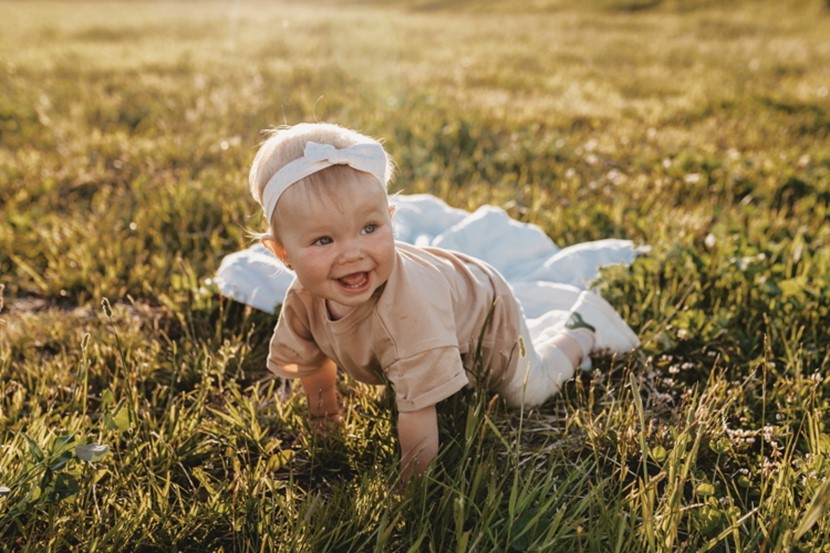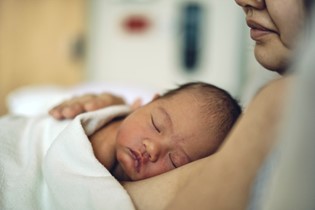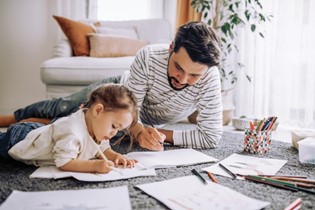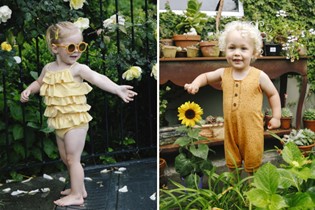Tips to help your baby sleep while away from home

Dorothy Waide offers her tried-and-tested solutions for peaceful summer slumbers and happy holidays.
Temperature in baby’s room or sleep space
- The ideal temperature for Baby's nursery or sleep space is around 18°C to 20°C; this can be hard to achieve in homes that don’t have air conditioning and rely instead on fans for cooling rooms down.
- Good black-out blinds or curtains can help cool the room by some degree – each home will differ.
- Reversing the blades of a ceiling fan allows cooler air to be pushed down.
- Close window coverings during the hottest time of the day, to help keep the hot air out.
- A dehumidifier will take the moisture out of the air so the humidity drops. It may seem to blow warm air out, but as the moisture gets taken out of the air, the temperature will drop.
- Placing a bucket of ice in front of a moving fan will give the room a quick, cool blast right before sleep time.
- To cool down a toddler’s bed, freeze a hot water bottle with a little water in it and place it in the bed for a while. Remove before sleep time.
- If you have air conditioning in your baby’s room, set it to about 20°C. If the room feels really hot, blast the room before your baby goes down for a nap or bedtime. After it’s cooled down, change it to the fan setting so air is moving throughout their nap or night-time sleep.
- Putting damp, cool socks on babies' or toddlers' feet is a good way to lower their temperature if it is spiking.
Dressing a baby/toddler
- I recommend 100% cotton in summer, for sleep and for play, because it absorbs moisture.
- For newborns, I suggest always dressing them in a 100% cotton onesie with either no sleeves or short sleeves. In hot temperatures, it’s always better to have a thin, breathable layer between their skin and yours.
- If you're safe swaddling, use a large 100% cotton muslin cloth or swaddle. On really hot days or nights, you may find the swaddles with layers of wrapping fabric are too hot.
- To tuck a newborn baby into bed, I would swaddle them, place them in their bassinet or cot, and tuck over a large muslin cloth.
- For babies who are out of their swaddles for daytime naps, I would use a 0.5 tog sleeping bag (similar weight to a cotton sheet) and no blankets or sheets. For night-time, it depends on whether your baby is in an air-conditioned room or not, but I would suggest replacing the short-sleeve body suit with a long-sleeved cotton one and a 0.5 to 1.5 tog sleeping bag. It also depends on how cold the room gets in the early hours and on how many layers you use for night sleeping. I tend to have babies a little warmer when they go to bed so that when the temperature drops in the early hours, they are still warm enough. Sleeping bags should be 100% cotton for moisture-absorbing properties and to avoid overheating. It’s extra important to keep little ones with skin issues cool, as their skin tends to play up in the heat.
Naps over the holiday season
- How do we manage outdoor life with a young baby? The 'fourth trimester' (0 – 12 weeks) is where I hold and work towards self-settling and resettling, knowing full well that babies do not get the tools on board to do this until they're at least 12 weeks old. Whatever you do in the fourth trimester will set you up as your baby grows. There is no right or wrong way to parent, but there are hard ways and easy ways. Parenting is a lifelong journey. My best advice is try not to do anything in your arms that you cannot replicate in the cot.
- I like to try a moving nap for the first sleep of the day (if it’s not too early). It does everyone the world of good to go out and get some fresh air. By the time your baby is six months old, I would suggest wake cycles of about 2¾ to 3¼ hours, and two naps a day. This means that the whole family can have a siesta in the early afternoon (like the Europeans do), and adults can enjoy a longer evening.
- If I'm going to do moving nap, I try where possible to get Baby to settle in the pram, buggy, or carrier without movement, and then take off for my walk. Of course, if they're unsettled, get going! By encouraging Baby to settle without movement, you’re giving them the opportunity to self-soothe and resettle on their own with little intervention. If this happens, you can go anywhere with them, as they'll be able to transfer from cot to car, and car to buggy, train or plane, and resettle nicely.
- If you are out and about and having naps on the move all day, then I always suggest making the next day a quiet one. When I was travelling overseas with families, once settled into our new destination we would have a fun day out and about, but the next day we would stay home and get back into the routine. Overtired toddlers and babies are not the best company, so it’s a balancing act, especially if you have older kids who want to be out and about.
Naps on the move
- With prams, buggies, carseats and capsules, it’s really important to understand that they do get hot, so dress your child accordingly. There's no need for babies to wear hats in the pram during summer (they can slip down and be a suffocation risk). Ensure that you are using a UPF (ultraviolet protection factor) cover that has good air ventilation.
- I also suggest using a cotton liner for strollers, carseats and capsules to absorb moisture and keep your baby or toddler cooler. It also enables the seat to be kept clean if you are out and about and they’re eating in there.
- Remember to also cover a capsule or carseat with a towel or blanket if you’re parking in direct sun to prevent the seat and buckles from getting hot. Always make sure they’re okay before lifting your little one into their seat. I also recommend the sun covers that you can place in the window as these will help reduce the inside heat a little, as well as blocking the sun while driving.
- Remember the air conditioning actually has to go to the back of the car and then come forward to help cool a baby in a capsule. Don’t overdress an infant who is travelling in a car, and again, remove their hat.
- Some stroller brands like NUNA have a removable insert so babies and toddlers can sit on mesh which is great for airflow. When buying a buggy or pram, I would look at how easy it is to fold and fit in the boot of the car, whether it has good ventilation and useful accessories such as a sun shade.
- In the old days, we would always peg a muslin cloth over the hood of the pram covering the baby to keep the sun out, especially when they were asleep. However, this is not recommended anymore because it can actually trap hot air in. Breathable UPF cover protections are much safer.
Front pack and sling snoozes
- Many front packs come with a head shade protector which cuts out a lot of light and protects your little one from the sun. If your front pack doesn’t come with a head shade protector, then you can purchase a special sunshade which covers your baby while out and about. If it’s really hot, placing a muslin cloth between you and your baby will help absorb moisture and prevents things getting too hot and sticky.
- Ensure your carrier is suitable for hot weather, and if you are thinking of having your baby in the water, choose a carrier that is okay to get wet.
- If you're using a sling, ensure it is made of breathable material, and that your baby will not overheat with too many layers of material. Also check they have good ventilation, especially if the head shade is up.
- And when you're out enjoying the golden weather, remember to check that little feet and legs are covered to avoid being burnt by the sun.
Thirsty work
- Babies who are fully breastfed don’t need additional water until they're around six months old. The reason for this is that in summer your body makes more foremilk, which quenches a baby's thirst. In winter, your body makes more hindmilk with more of the fat that babies need for the colder weather. I’ve seen this first-hand in expressed breastmilk from the mothers I’ve helped over the years, while travelling from a cold climate to a hot one. Breastmilk is amazing! On particularly hot days you may want to feed at least twice in a wake cycle to ensure your baby keeps hydrated.
Lunch battles
- When it’s swelteringly hot, older babies and toddlers may not feel like eating during the day. This is no reason to stress. I tend to make up cold and refreshing smoothies to get goodness into them that way.
Mozzie protection
- We have lots of flying bugs here in New Zealand. I suggest using insect screens over the windows in baby’s room so you can rest assured that a mosquito, bee or wasp can't fly in through open windows while your little one is asleep.
- I wear a good insect repellent on myself so that when I'm holding a baby, they too will be protected. Putting insect repellent on a baby's skin is not advised. For toddlers, I tend to do their ankles and neck – but always try the product on a little patch of their skin first to make sure there are no adverse reactions. Don’t put repellent on their hands as they can lick them – and it doesn’t taste very nice at all!
Sleeping while boating, camping and in a holiday home
- Little ones certainly do need a lot of luggage on holiday – if you're a first-time parent, you may find that the car boot will be mostly filled with your baby's gear, with little room left for yours! Usually I would pack only the favourite toys, but if space is limited, then it's best to prioritise the things needed for sleep. Toddlers really just need a bucket and spade and perhaps one or two other toys.
- If you are going to be staying in a bach or on a boat, then I suggest using the Safe-T-Sleep – a product that straps your little one into their sleeping space and ensures they're safe from rolling out of bed. This is especially handy on a yacht.
- If you’re unsure about the quality of the water where you are staying, always boil it then cool it before using, or use bottled water to keep everyone's tummies safe. For more information on this topic, check out healthed.govt.nz.
- A baby monitor that runs on batteries is a good idea for when you're camping.
- If you're planning day trips, check the weather forecast and try to be inside at the hottest part of the day.
- Never take your eyes off little ones near water – they can drown in just two inches of water. If you’re with a group of friends, discuss who is watching the kids and when. Accidents can – and do – happen when one parent thinks the other one is watching, and vice versa.
- Encourage your little ones to wear sunglasses as well as a hat. Chill out, be practical and be prepared. Being prepared enables you to be less stressed and everyone to have a more enjoyable holiday.

Dorothy Waide is a Karitane Mothercraft Nurse with over three decades of experience. She's also the OHbaby! expert sleep advisor and resident Baby Whisperer. Dorothy is the author of two popular parenting books, You Simply Can’t Spoil A Newborn and Simply Parenting: From 12 Weeks To 12 Months. Visit Dorothy at babyhelp.co.nz.
Photography: @christyhermogenes via Twenty20

AS FEATURED IN ISSUE 52 OF OHbaby! MAGAZINE. CHECK OUT OTHER ARTICLES IN THIS ISSUE BELOW

















